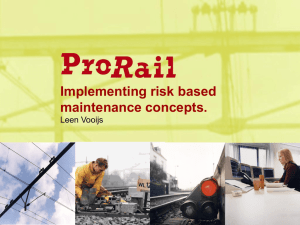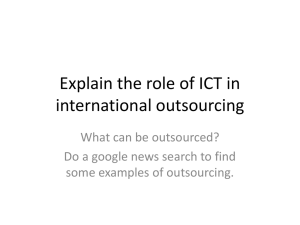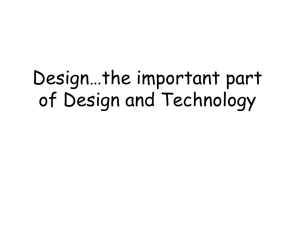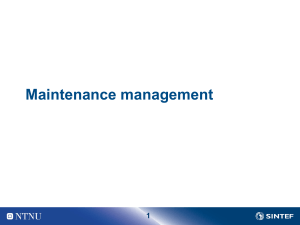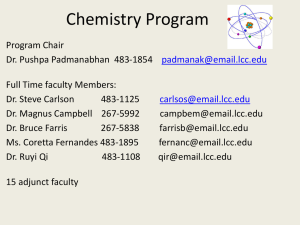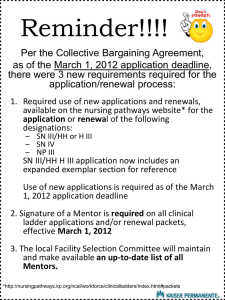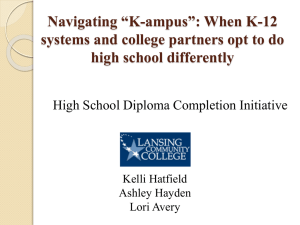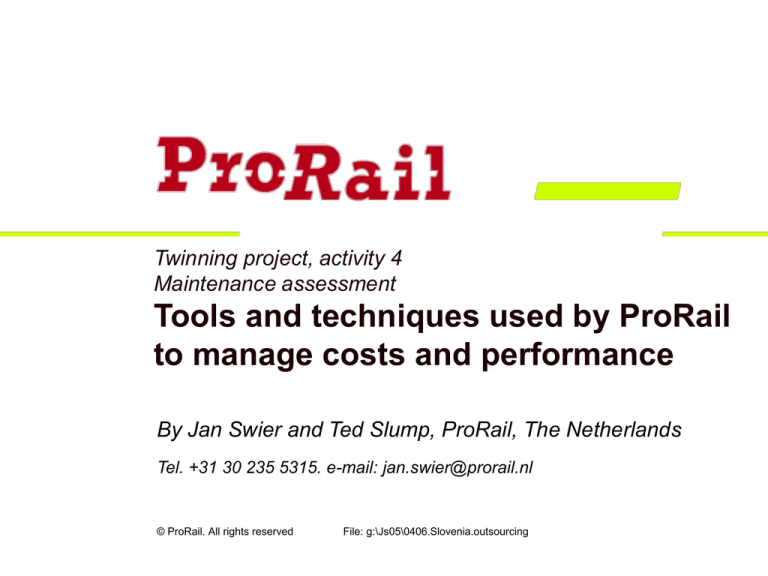
Twinning project, activity 4
Maintenance assessment
Tools and techniques used by ProRail
to manage costs and performance
By Jan Swier and Ted Slump, ProRail, The Netherlands
Tel. +31 30 235 5315. e-mail: jan.swier@prorail.nl
© ProRail. All rights reserved
File: g:\Js05\0406.Slovenia.outsourcing
General approach
outsourcing
Maintenance
New/Renewal:
superstructure
New/Renewal:
substructure
Design &
Engineering
Outsourcing strategies in Europe
Holland
Finland
)*
)* 100% inhouse
Ireland
Spain
England
Unstable, big changes
Germany
Sweden
)**
)** 100% inhouse
Italy
Conclusions:
1.
Within Europe there are big differences in
the degree of outsourcing.
2.
Only in Holland all the execution of work is
outsourced.
3.
Outsourcing of maintenance is unusual.
4.
Broadly speaking the cost effects of
outsourcing are indistinct.
Norway
Switserland
Austria
Denmark
Belgium
France
VS; Amtrak
Degree of outsourcing
Appraoch
Most work inhouse
Conservative
Partly outsourced
Outsource initiatives
Most outsourced
Innovative,broad adopted
2
Context
assessment
Outsourcing of Maintenance & Renewal
LC Costs
RAMS quality
Functionality
Renewal
Interaction
Interaction
Small-scale
maintenance
Result: a PRODUCT
Long Term reaction time
Trigger: degradation
Result: a SERVICE
Short Term reaction time
Trigger: RAMS & functionality
Large-scale
maintenance
Result: a PRODUCT
Middle Long Term reaction time
Trigger: quality improvements
RAMS = Reliability, Availability, Maintainability, Safety
LC= Life Cycle
© ProRail. All rights reserved
3
Small-scale maintenance is outsourced
with three types of contracts
Track
Bridges
Level Crossings
RAILINFRA
39x Process contracts
3x Process contractors
Many project contracts and
contractors
Energy supply
Signalling
Telecom
Posts (Traffic Control)
Stations
TELEMATICA
1x Framework contract
16x Sub-process contracts
1x Consortium of contractors
STATIONS
1x Management
agreement
with NS Stations
4
Contract boundaries between Signaling,
Telecom and Posts
Main Post
Operation
s
EBP
EBSgate
Glass fiber
Copper cable TEL.
Copper cable signaling
Sub Post
Contract boudary
Relais
Case
Sub Post
EBP
EBP
VPI
B-relay
VPI
Process Contract A
Relais Case
Process Contract B
None Failsafe technique
EBS
Sub Post
Failsafe technique
Relais Case
Process Contract C
5
Outsourcing; allocation of tasks
Outsource
Audit
Specify
Input
Proces
Output
Measure
Measure
Evaluate &
Improve
Planning of work
Preparation of work
Execution of work
Inspections
Check
Check
Evaluate &
Improve
Report
© ProRail. All rights reserved
Legenda:
ProRail
Contractor
6
Typical OPC-contract
*Integral maintenance contract for all technologies: electrical & civil engineering
*Service contract; not calculated on results but on efforts
*Separate accreditation scheme for maintenance and fault repair
*Model OPC is standard; uniformity, unambiguity
*Contracting guide with process worked out
*Skeleton contract with a duration of 5 years, with annual meetings about changes
*Prescribed inspections linked to specifications
Explanatory descriptions
*Generic risk analysis of the process
(Descriptions of what to do/in which order/by whom/in which context
Contract guideline
*Open budget as support for the offer
The steps to be followed in sequence to arrive at a contract
*Specifications at four cohesive levels
Model agreement
*Risk inventorisation of safety
Model contract
AVPI
APPENDIX 1
(General
Conditions
for Process
contract
Upkeep)
Exceptions
and
supplements
to the generic
Conditions and
specifications
APPENDIX 2
ProRail B&I
APPENDIX 3
Contractor
Definition
Quality plan
(What demand) (How delivered)
Risks +
risk sharing
APPENDIX 4 APPENDIX 5
Generic
Generic
standards/
relevant
specifications background
information
Price +
Description
OPC = Output Process Contract
changes
© ProRail. All rights reserved
Annual agreements
7
Punctuality & Capacity
Customer
Top requirement for public rail transport
RAMS(HE) Specifications
Board
Area
RIB business targets per (contract) area
Managers
Systems
Technicians
Objects
Contractor
© ProRail. All rights reserved
Activities
Integrated Quality Indicators
Time-related quality figures for infrastructure systems
Maintenance Specifications
(Minimum) technical wear and objects’ wear limits
Inspection & maintenance actions
Railinfra mngt. TOCs
Performance is specified and managed at
four (related) levels
RAMSHE = Reliability,Availability,Maintainability,Safety,Health,Environment
TOC = train Operationg Company
8
Measuring and reporting on Quality is
outsourced. It is a highly skilled business.
OUTSOURCED: measures and reports on quality
Non-standard
quality
measurements/
inspections
ProRail
© Railinfrabeheer
Standard
quality
measurements
(according to
contract)
Defects
Non-standard
quality
measurements/
inspections
Contractor
9
Four types of quality measurements/inspections
Types of inspection:
Characterisation:
Ordering method:
• Visual inspection (compulsory by law)
• Guaranteeing safe operation
• Report limited to nonconformities
• More frequent than operational inspection
• 100% process contract
Operational
inspection
•Visual inspection
• Guaranteeing operation
• Report limited to nonconformities
• Systematic, at least 1x per year
•100% process contract
Quality
inspection
• Often involving specialist equipment
• Quality assessment
• Uniform inspection report
• Performed systematically
•partly process contract
•partly project order
Technical
inspection
• In-depth inspection with specific objective
• Performed occasionally
• Unique inspection report
• Specialist
•100% project order
Inspection
10
Overview of Quality measurements
1. Failure and punctuality recording
2. Measuring trains (track, US, catenary, ATC,..)
3. Inspections:
* “schouw” (frequent inspection of lines on foot )
* functionality
* quality
* technical
4. Telemonitoring systems
5. Audits
ATC – Automatic Train Control
US = Untra Sonic
11
Output management tools (to manage
costs and performance)
1. Specifying and measuring performance at levels
2. Calculating and accounting costs at levels
3. Maintenance management techniques & tools
(e.g. RCM, FMECA, Risk Analysis, Maintenance Concepts, etc.)
4. Process Control / Quality Management
5. Benchmarking; internal and external
6. Modelling:
*
*
*
Costs and Performance
Conditions and Costs
Utilisation and Functionality
RCM = Reliability Centrend Maintenance
FMECA = Failure Mode Effect and Criticality Analysis
© ProRail. All rights reserved
12
Evaluation of outsourcing small scale
maintenance in 2001
The contract and contracting process were quite
satisfactory, but …………..:
–A market with nearly no competition,
–no clear insight into costs and the relationship with the
performance delivered,
–insufficient specifications and instruments to work with RAMS,
–insufficient collaboration,
–sub-optimisation; contractor too focussed on own operating results,
and ProRail specified the results insufficiently.
In 2001 the OPC+ project has started
© ProRail. All rights reserved
13
OPC+: changing the relation with
small scale maintenance contractors
* Need of short term improvement.
* Introduce professional asset
management skills and instruments.
* Share information and knowledge with
Process contractors.
* Shared targets for 2006.
14
Results OPC+
Data systems linked to automatic data
synchronisation for failures
First transition step organisations
Management Control and Reporting System
installed and KPI dashboard
Failure reduction –20% compared to 2002
EUR 40 million (20%) efficiency improvement
New maintenance guidelines with classes
Experiment with new schedule for train free periods
for maintenance
Joint vision of relationship in 2007and sustainable
results
KPI = Key Performance Indicator
15
Lessons learned
1.
Outsourcing of maintenance projects (like renewals and
large scale maintenance) has big advantages and is not
very risky.
2.
Outsourcing of small scale maintenance is difficult
because:
–
–
–
–
–
3.
There is no real competition.
The result is a service (RAMS) and not a product.
Integral skills of the contractors are needed (civil, signaling, high voltage)
New instruments and management skills are needed.
An unusual attitude of the contractor; dedicated to maximize quality/cost ratio
You have to know your business and be in control of it:
–
–
–
–
Only if you can specify and measure it, you can manage it.
Skilled people and dedicated instruments are needed to manage costs and performance.
Know your infrastructure, costs realised and minimum quality accepted.
Reorganise your processes, instruments and skills to control improve results.
16
Advice
1.
2.
3.
4.
Do not outsource maintenance if you don’t know how to
stay in control of costs and performance.
Outsource step by step: plan, separate, split-off and
outsource.
Outsourcing should not be a goal but a way to improve.
Outsourcing needs a cultural change and takes time.
Statements
*The market will not give you anything for free.
*Outsourcing is not a solution for your financial or managerial problems.
*Tasks are outsourced, but the end-responsibility for the overall result not.
© ProRail. All rights reserved
17
Maintenance management;
how to manage the relation cost-performamce
Introduction and developments
The relation between Costs and Performance
has to be managed in levels
.
Rail infrastructure
Railinfrastructur
Network
Director
Network
Lines
Lines
Systems
Systems
Objects
Activities
Costs
Managers
Objects
Technicians
Components
Mechanics
Performance
(RAMS)
Organization
19
To manage performance (RAMS) dedicated
instruments and quality assurance are needed.
RAMS specs in
a contract
RAMS
specs
Consequence:
full process control &
dedicated instruments
Maintenance
Engineering
Safety case
Risk Analysis
RAMS
specs
RAMS
specs
Reliabilitycentred
Maintenance
Maintenance Concept
See
EN 50126
Work plan
© ProRail. All rights reserved
20
EN 50126 give ProRail a frame work to
organize processes and process control
Application EN 50126:
*how to control Processes to
optimise RAMS and Costs
*based on Specification and
Demonstration of RAMSrequirement / risks
….for the whole life cycle
….for all railway systems
….for all parties in the business
….for new and existing systems
21
Maintenance Concept is the tool to
relate costs and performance
Object
Failure Modes Chances & Effects M&R activities
Part
Failure Failure Condition Life Failure Effect on:
form
cause of the fault Time duration RAMS Costs
Specs
M&R Activity Costs/ Sequel Costs/ Minimum
strat.
activity action action technical
failure
specs
SAO
TAO
GAO
Risk Analysis
From failure
registration
Maintenance Concept
Maintenance,
Renewal,
Inspections
SAO = Failure dependent maintenance
TAO = Condition dependent maintenance
GAO = use dependent maintenance
22
Maintenance Mgmt. tools are introduced to manage
the relation between RAMS-Risks and Costs
Knowledge
Infrastructure
Risk Analysis
Availability
Utilisation
Money
The “maintenance &
renewal” black box
Reliability
Infrastructure
according to
specifications
Maintenance
& Renewal
Circumstances
Safety
Environment
Costs
Maintenance Concepts
© ProRail. All rights reserved
23
Data & knowledge will
be (re)organised
© ProRail. All rights reserved
24
Life Cycle Management (= LCM)
Implemented process and skills
Example: LCC analysis of a switch 1:9 and
LCM optimized renewal plan track & switches
Why Life Cycle Cost Management?
Avoid decisions based on short-term
thinking and/or “emotions”.
LCC helps to make consequences visible
on long term.
Improved reasoning behind and
determination of decision.
Availability of the infrastructure and
expenditure are set off against one
another.
26
Principals of Life Cycle Cost Management
25
Yearly maintenance costs
Average yearly depreciation costs renew al
LCC; maintenance + renew al
Cost index
20
Lowest LCC
15
10
Technische life
5
Economical Life
40
37
34
31
28
25
22
19
16
13
10
7
4
1
0
Realized life
LCC = Life Cycle Costs
Controled
Loss of quality
Loss of Function
(Growing) loss of Quality
27
% Cost reduction potential
High Life Cycle Cost reduction potential
in an early phase of a project
Building proces
Strategy
Design
Build
Maintain
& Renew
28
(Life Cycle) Cost reduction potentials
in the Value Chain
“Value Chain”
Strategy
Design
Build
Maintain
& Renew
“Efficiency Chain” and examples of cost reduction solutions
Systems,
Parts
Processes,
Operational
demands
Layout,
Complexity
Functional
specifications
instead of
technical
solutions.
Infra solutions. Quality.
Mechanisation. Train Free
Periods.
Switch density. Specifications. Planning.
Site management.
Tendering.
Norms.
Market
Technical
developments.
solutions.
Organisation Productivity
Efficiency &
Effecitivity
Optimize M-cost
and R-costs
Maximize life time
Continuous
improvement
29
LCC Management has introduced in 2000
LCC calculation programme
LCC training with course material
Infranet
Helpdesk
30
LCM-step-by-step method ProRail M&R
1.
2.
3.
4.
Define project
Generate variants
Determine preference variant
Report findings
M&R = Maintenance & Renewal
31
Results following introduction of LCC
Management
LCM knowledge database with >150 LCC considerations
M&R: for production planning process & investments
New lines: for availability request
Increased interest for financial aspects
Improved recording of decisions
LCC as basis for (new) M&R policy
LCC = Life Cycle Costs
M&R = Maintenance & Renewal
32
Dashbord / kpi’s
Kpi = key performance indiactor
Dashboard Board of Directors
TAI
FRT
TFP
KPI
BoD
BoC
MoT
IM
IP
TC
CM
ICT
P&C
HRM
ROA
Train Affecting Irregularity > 3 min.
Function Recovery Time
Train Free Period
Key Performance Indicators
Board of Directors
Board of Commissioners
Ministry of Transport, Public Works and Water Management
Infra Management
Infra Projecten
Ttraffic Control
Capacity Management
Information Management
Planning and Control
Human Resource Management
Result Oriented Assessment of employees
34
Dashbord M&R Director
RAMS KPIs:
•Number of TAOs
•* Duration of TAOs
* Type of TAO: four origin codes and endogenous/exogenous
RAMS KPIs:
KPI
(RAMS)
SKI
Upkeep
specifications
Activities
* Utilisation of maintenance schedule and
Train Free Periods
TRACK:
* Track geometry figure
* Track geometry incidents
* Visual quality of switches
* Guide geometry of switches
LEVEL CROSSINGS: * Visual quality of crossings
SAFETY:
* ATC incidents
POWER SUPPLY: * Contact wire thickness
* Incidents because of geometry
35
Main developments within ProRail M&R
1.
2.
3.
4.
5.
6.
7.
8.
9.
10.
Growing income from user charge (15-20%)
Performance contracts with train operators and government
Transformation from a task- into a process-orientated organisation
Introduction of RAMS/Maintenance management techniques
Introduction of dashboard with key performance indicators
RAMS specifications in Maintenance, Design and Build contracts
Improved cost and quality management and their interrelationships
Alliance contract for relationship with maintenance contractors
Combined database with maintenance contractors
Introduction of Decision Support Systems to improve foundations and
prioritising of projects in production plan
11. Long term renewal plans (25 years)
12. ProRail database with cost norms, cost calculations and LCC cases
13. Innovation in: contracts, quality measurement, telemonitoring,
management information systems and modelling & forecasting
36
Our ambition:
the best rail inframanager
of Europa
37
Thank you for your attention
Any questions?
38

